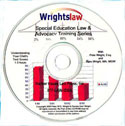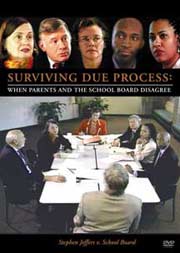|
|
|
If your tax records are in a mess - come April, so are you. Documenting your deductions is essential.
Good documentation is also essential for effective advocacy.
"If it was not written down, it was not said. If it was not written down, it did not happen." -- Pete Wright
Train yourself to write things down! When you write things down when they happen, you are taking steps to protect your child's interests.
In this issue of the Special Ed Advocate you'll learn why it is so important to create paper trails, and how to document your contacts with the school - conversations, meetings and other events. Your paper trail may become important evidence if you need to prove your child's case.
It's easy, but it's essential.
Don't hesitate to forward these tips to other friends and colleagues.

Sign up free today! l Read previous issues |
|
| "If It Wasn't Written Down, It Was NOT Said" |
Don't rely on your memories of an event. Memories are influenced by emotions. Write things down when they happen.
Documentation that supports your position is a key to making your case and resolving disputes early. Learn how to do this in Paper Trails, Letter Writing, and Documentation.
On the Documentation page you'll see how to advocate for your child by the letters to you write and how to use logs and document contacts and problems.
|
back to the top |
|
| Using the Problem Report to Resolve Problems |
Do you have ongoing problems with the school? Despite your attempts to resolve the problems, nothing changes?
Does the school send your child home or suspend him frequently? Do other students bully your child at school? Is the teacher refusing or failing to implement the IEP? Do you have concerns about your child's IEP?
In Using Low-Tech Tools to Create Paper Trails, you'll learn how to use the Problem Report to document ongoing school problems and your attempts to resolve these problems. The Problem Report provides answers to “Who, What, Why, When, Where, How and Explain” questions.
When the problem occurs again, fill in the Problem Report and return one copy to the school (retaining one copy for your child's file). Your Problem Report will become part of your child's file. If the problem occurs again, fill in another Problem Report and send a copy to the school.
Each time you send another Problem Report to the school, you are creating a paper trail that may help resolve the current problem and protect your child in the future.
|
back to the top |
|
| Using Simple Low-Tech Tools to Create Paper Trails |
If you have a dispute or disagreement with the school, how can you prove it? What evidence do you have of your attempts to resolve the problem?
In Using Low-Tech Tools to Create Paper Trails, you learn how to use logs, calendars, and journals to document problems and your attempts to resolve the problem. A paper trail often helps to problems to resolve quickly.
Keep a log of your contacts with the school. Your log should include telephone calls and meetings, conversations, and correspondence between you and school personnel. If you have a dispute with the school, your contact log is independent evidence that supports your memory - it's golden.
You don't need complicated computer programs or high tech equipment to create a paper trail. Your tools are simple:
| Date |
Contact Log: Telephone Calls |
| Who |
|
| When |
|
| What you wanted |
|
| What you were told |
|
| Notes |
|
Your log is a memory aid that will help you remember what happened and why.
Find more logs you can use to record -
When you document problems by writing letters and creating a paper paper trail, you must assume that your letters will be read by a Stranger who has the power to right the wrongs. |
back to the top |
|
| Writing a "Letter to the Stranger" |
As you describe events, concerns and problems, remember the decision-making Stranger who has the power to grant your requests. When the Stranger reads your letters, the Stranger will understand your perspective and want to fix your problems.
Want to learn more about this "Stranger"?
When you read the original "Letter to the Stranger" you will see how this concept evolved. * Required Reading at Wrightslaw - the Original "Letter to the Stranger" by Janie Bowman and Peter Wright.
These articles will help you put these concepts into practice.
The Art of Writing Letters l The 12 Rules for Writing Effective Letters.
Wrightslaw: From Emotions to Advocacy, 2nd Edition by Pam and Pete Wright teaches you how to create paper trails, write effective letters and more.
Chapter 22 teaches you how to document problems and handle telephone calls.
Chapters 23 and 24 teach you how to write powerful evidence letters and persuasive “Letters to the Stranger.” These chapters also include sample letters that you can tailor to your circumstances.
|
back to the top |
|
|






